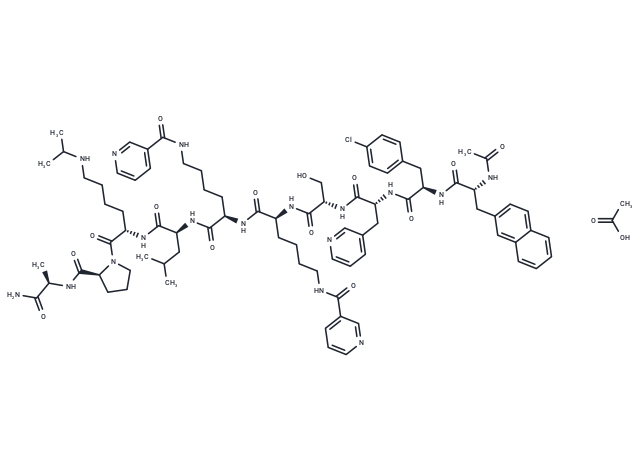Shopping Cart
Remove All Your shopping cart is currently empty
Your shopping cart is currently empty
Antide acetate is an LHRH antagonist and represses LH and FSH release from the pituitary gland.

| Pack Size | Price | USA Warehouse | Global Warehouse | Quantity |
|---|---|---|---|---|
| 1 mg | $196 | In Stock | In Stock | |
| 5 mg | $441 | In Stock | In Stock | |
| 10 mg | $592 | In Stock | In Stock | |
| 25 mg | $918 | In Stock | In Stock | |
| 50 mg | $1,180 | In Stock | In Stock | |
| 100 mg | $1,660 | - | In Stock | |
| 200 mg | $2,250 | - | In Stock |
| Description | Antide acetate is an LHRH antagonist and represses LH and FSH release from the pituitary gland. |
| In vivo | Analogs of GnRH, including agonists (GnRH-a) and antagonists (GnRH-ant), have been widely used to inhibit gonadotropin pituitary release.?Aside from the effect of GnRH analogs on the pituitary-gonadal axis, studies have shown that GnRH has extrapituitary effects, particularly on rat and human ovaries.?In the present study, we evaluated the direct in vivo effects of the GnRH-a, leuprolide acetate (LA), or the GnRH-ant, Antide (Ant), either singly or together, on ovarian follicular development in prepubertal eCG-treated rats. |
| Synonyms | Antide acetate (112568-12-4 Free base) |
| Molecular Weight | 1651.34 |
| Formula | C84H112ClN17O16 |
| Smiles | C[C@H](C(N)=O)NC([C@H]1N(C([C@H](CCCCNC(C)C)NC([C@H](CC(C)C)NC([C@@H](CCCCNC(C2=CC=CN=C2)=O)NC([C@H](CCCCNC(C3=CC=CN=C3)=O)NC([C@H](CO)NC([C@@H](CC4=CC=CN=C4)NC([C@@H](CC5=CC=C(Cl)C=C5)NC([C@@H](CC6=CC=C7C=CC=CC7=C6)NC(C)=O)=O)=O)=O)=O)=O)=O)=O)=O)CCC1)=O.CC(O)=O |
| Relative Density. | no data available |
| Color | White |
| Appearance | Solid |
| Sequence | Ac-D-2Nal-D-Phe(4-Cl)-D-3Pal-Ser-Lys(nicotinoyl)-D-Lys(nicotinoyl)-Leu-Lys(iPr)-Pro-D-Ala-NH2.CH3CO2H |
| Sequence Short | XXXSXXLXPA |
| Storage | keep away from moisture | Powder: -20°C for 3 years | In solvent: -80°C for 1 year | Shipping with blue ice/Shipping at ambient temperature. |
| Size | Quantity | Unit Price | Amount | Operation |
|---|

Copyright © 2015-2025 TargetMol Chemicals Inc. All Rights Reserved.